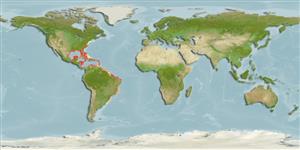Environment: milieu / climate zone / depth range / distribution range
Ecologia
marinhas associadas(os) a recifes; intervalo de profundidade 2 - 50 m (Ref. 9710). Subtropical; 45°N - 34°S, 98°W - 34°W
Western Atlantic: Canada (Ref. 5951), Massachusetts (USA) to Brazil, including Bermuda, the Gulf of Mexico and the Caribbean. Mediterranean Sea (Ref. 50345).
Tamanho / Peso / Idade
Maturity: Lm ? range ? - ? cm
Max length : 55.0 cm TL macho/indeterminado; (Ref. 40637); common length : 30.0 cm TL macho/indeterminado; (Ref. 5217); peso máx. publicado: 3.3 kg (Ref. 40637)
With small diffuse white spots; two areas where the hexagonal plates are dark-edged, forming chain-like markings, one on the pectoral region of the body and the other half way between gill opening and posterior end of carapace; large individuals lose the pale spots and chain markings and develop an irregular dark reticulate pattern over the entire carapace and caudal peduncle (Ref. 13442).
Inhabits seagrass beds, coral rubble areas, and offshore reefs down to about 50 m. Feeds on a wide variety of small benthic invertebrates such as mollusks, crustaceans, worms and sessile tunicates, as well as some sea grasses (Ref. 3696). Highly esteemed food fish in the Caribbean (Ref. 3696).
Ciclo de vida ou comportamento de acasalamento
Maturities | Reprodução | Spawnings | Egg(s) | Fecundities | Larvas
Robins, C.R. and G.C. Ray, 1986. A field guide to Atlantic coast fishes of North America. Houghton Mifflin Company, Boston, U.S.A. 354 p. (Ref. 7251)
Status na Lista Vermelha da UICN (Ref. 130435)
Ameaça para os humanos
Reports of ciguatera poisoning (Ref. 4690)
Uso pelos humanos
Pescarias: espécies comerciais; Aquário: Espécies comerciais
Ferramentas
Relatórios especiais
Baixar XML
Fontes da internet
Estimates based on models
Preferred temperature (Ref.
123201): 22.7 - 28, mean 25.5 °C (based on 450 cells).
Índice de diversidade filogenética (Ref.
82804): PD
50 = 0.6250 [Uniqueness, from 0.5 = low to 2.0 = high].
Bayesian length-weight: a=0.03548 (0.01700 - 0.07404), b=2.81 (2.62 - 3.00), in cm total length, based on LWR estimates for this (Sub)family-body shape (Ref.
93245).
Nível Trófico (Ref.
69278): 3.3 ±0.3 se; based on diet studies.
Resiliência (Ref.
120179): Elevada, tempo mínimo de duplicação da população menor que 15 meses (Fec assumed to be > 10,000).
Fishing Vulnerability (Ref.
59153): Moderate vulnerability (42 of 100).
Nutrients (Ref.
124155): Calcium = 21.6 [8.2, 68.6] mg/100g; Iron = 0.59 [0.29, 1.42] mg/100g; Protein = 19.1 [16.9, 21.3] %; Omega3 = 0.157 [0.081, 0.298] g/100g; Selenium = 20.9 [8.8, 45.9] μg/100g; VitaminA = 20.6 [5.1, 90.8] μg/100g; Zinc = 0.653 [0.415, 1.045] mg/100g (wet weight);
